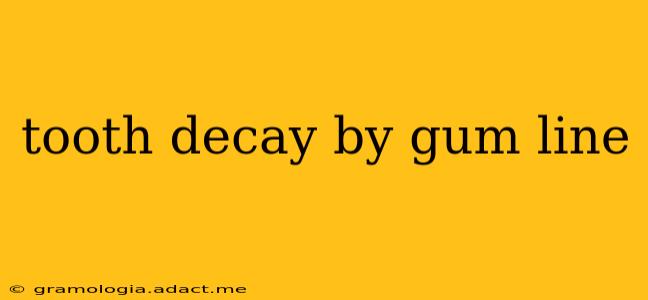Tooth decay, also known as dental caries, is a common problem that can occur anywhere on the tooth's surface. However, decay at the gum line, specifically in the area where the tooth meets the gum, presents unique challenges due to its location and often-difficult accessibility. This detailed guide will explore the causes, symptoms, and treatment options for gum line tooth decay.
What Causes Tooth Decay at the Gum Line?
Several factors contribute to the development of tooth decay at the gum line. Understanding these factors is crucial for prevention and effective treatment.
-
Plaque Buildup: Plaque, a sticky film of bacteria, constantly forms on teeth. If not removed through regular brushing and flossing, especially along the gum line, it can lead to acid production that erodes tooth enamel. The tight spaces between teeth and the gum line make thorough cleaning more difficult, making this area particularly susceptible.
-
Poor Oral Hygiene: Insufficient brushing and flossing allow plaque to accumulate, creating an environment ripe for bacterial growth and acid production. This is the most significant contributor to gum line decay.
-
Receding Gums: As gums recede, more of the tooth root is exposed. Root surfaces are less resistant to decay than enamel, making them more vulnerable. This often occurs due to gum disease (gingivitis or periodontitis).
-
Diet: A diet high in sugary and acidic foods and drinks significantly increases the risk of tooth decay. These substances feed the bacteria in plaque, accelerating the decay process.
-
Dry Mouth: Saliva plays a crucial role in neutralizing acids and washing away food particles. Dry mouth, caused by certain medications, medical conditions, or dehydration, reduces saliva's protective effect, increasing the susceptibility to decay.
What Are the Symptoms of Tooth Decay at the Gum Line?
Early-stage gum line decay might be asymptomatic, making regular dental checkups crucial. As the decay progresses, you may experience:
-
Sensitivity to Hot and Cold: This is a common sign that the enamel is compromised and the dentin (underlying layer) is exposed.
-
Discoloration: The affected area may appear darker or brown in color.
-
Pain: As the decay deepens, you may feel pain, particularly when chewing or biting.
-
Bad Breath: Persistent bad breath (halitosis) can also indicate the presence of decay.
-
Visible Cavity: In advanced stages, a visible hole or cavity may be present at the gum line.
How is Tooth Decay at the Gum Line Diagnosed?
Your dentist will conduct a thorough examination, including a visual inspection and possibly x-rays to diagnose gum line decay. X-rays are particularly important for detecting decay hidden beneath the gum line or in between teeth.
How is Gum Line Tooth Decay Treated?
Treatment depends on the severity of the decay:
-
Fluoride Treatments: For early-stage decay, fluoride treatments can help remineralize the enamel and halt the progression of the disease.
-
Fillings: For moderate decay, fillings are used to remove the decayed portion and restore the tooth's structure. These fillings can be made from various materials, including composite resin (tooth-colored) or amalgam (silver).
-
Crowns: In cases of extensive decay, a crown (a cap that covers the entire tooth) may be necessary to protect and restore the tooth.
-
Root Canal Treatment: If the decay reaches the pulp (the inner part of the tooth containing nerves and blood vessels), a root canal may be required to remove the infected tissue and save the tooth. Sometimes, extraction may be necessary if the decay is too extensive to save the tooth.
Can Gum Line Decay Be Prevented?
Yes, diligent oral hygiene and regular dental visits are crucial in preventing gum line decay.
-
Brush Twice Daily: Use a soft-bristled toothbrush and fluoride toothpaste, focusing on the gum line.
-
Floss Daily: Flossing effectively removes plaque and food particles from between teeth and the gum line.
-
Use Mouthwash: An antimicrobial mouthwash can help reduce bacteria in the mouth.
-
Visit Your Dentist Regularly: Professional cleanings and checkups are essential for early detection and prevention of tooth decay.
-
Maintain a Healthy Diet: Limit sugary and acidic foods and drinks.
-
Treat Gum Disease: If you have gum disease, address it promptly to prevent gum recession and subsequent decay.
Does Tooth Decay at the Gum Line Always Hurt?
No, tooth decay at the gum line doesn't always cause pain, especially in the early stages. This is why regular dental checkups are essential for early detection and prevention.
How Can I Prevent Gum Recession?
Gum recession is often linked to aggressive brushing, gum disease, and genetics. Practicing gentle brushing techniques, maintaining excellent oral hygiene, and receiving prompt treatment for gum disease can help prevent gum recession. Your dentist can advise on the best practices for your specific situation.
This information is for general knowledge and does not constitute medical advice. Always consult with your dentist for diagnosis and treatment of tooth decay or any oral health concerns.
